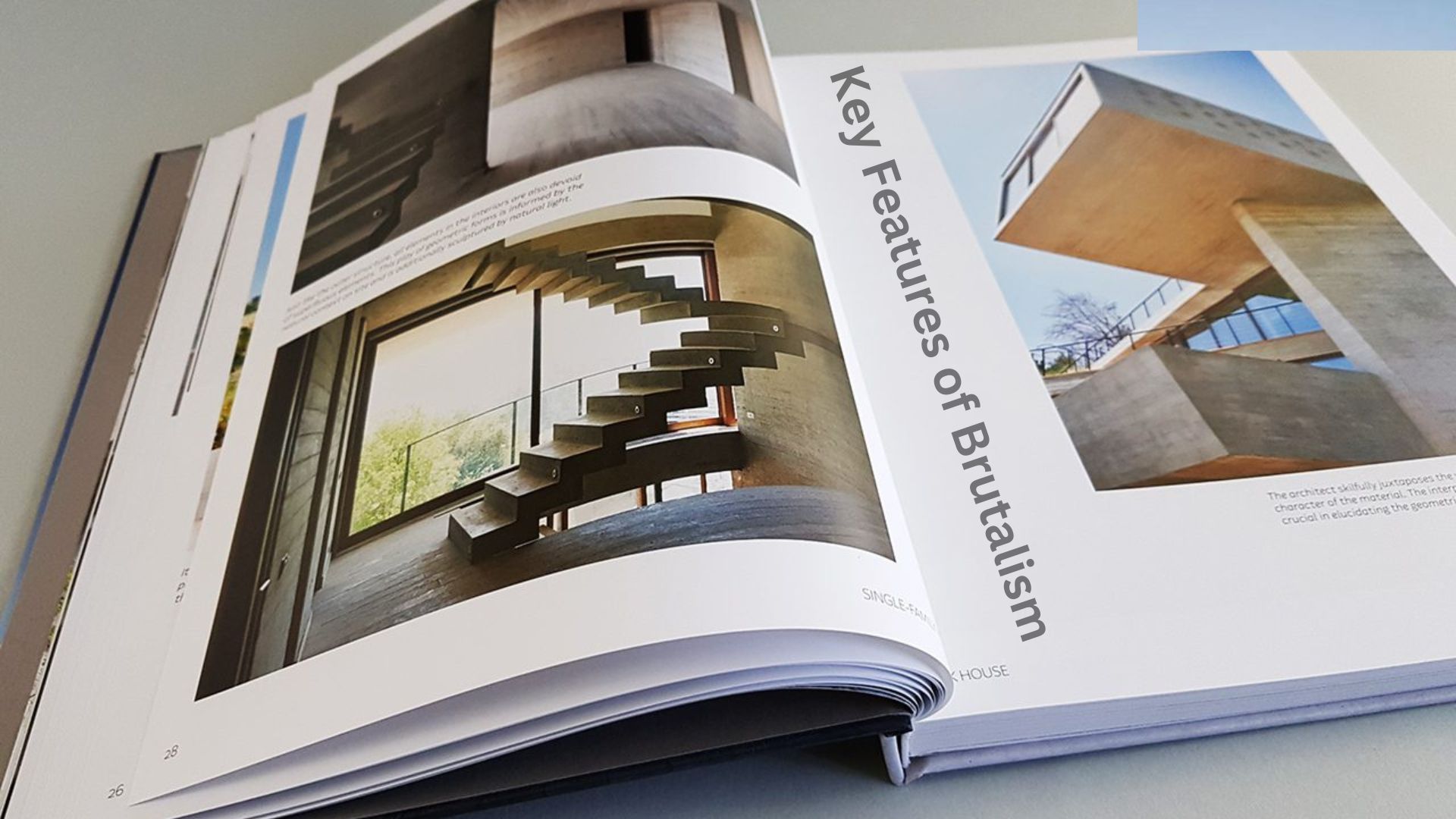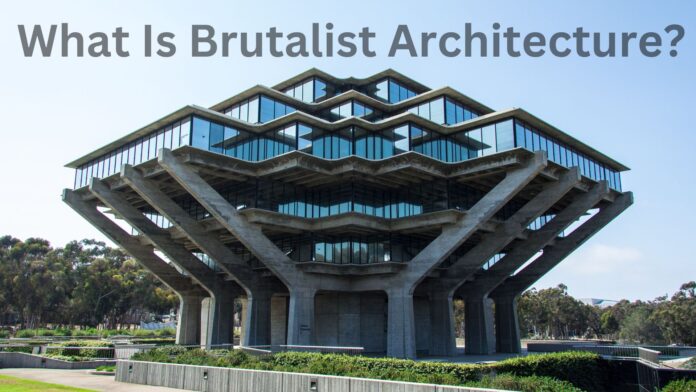What Is Brutalist Architecture? Key Design Elements to Know. Brutalism is frequently portrayed as an antagonistic style within architecture. No other buildings blend in with these massive, plain concrete edifices. Famous examples of the rare version of Brutalism include the Denys Lasdun–designed National Theatre in London and the William L. Pereira & Associates–designed Geisel Library at the University of California, San Diego.
The goal of the brutalist style is far from aggressive despite its violent appearance. Many have pointed out the Brutalist era’s intimidating and harsh style. “But I’ve always thought it shows a great mastery of basic geometric shapes,” remarks Will Choui, a modernist furniture designer who works in the Brutalist approach. “Brutalism, in my view, is the pinnacle of unfiltered design—a bold and honest movement that merits praise for its boldness and honesty.”
History of Brutalist Architecture

Le Corbusier coined the French word “béton brut” to define brutist concrete’s rawness. The Brutalist movement was named after this phrase. The phrase “brutalist” evolved with British architecture. According to New York City architect and historian Kate Regev, brutalist architecture emerged in postwar Europe, mainly the UK, in the 1950s and gained appeal in the US in the 1960s. “It used a simple, modernist design to produce functional structures, usually from concrete, with simple shapes that were ‘honest’ about the building’s materials and construction. This time saw a surge of practical, efficient Brutalist designs for public, private, and academic structures as cities expanded and rebuilt. “the emphasis on simplicity and efficiency was essential in post-war construction,” according to Choui.
In the 1970s and 1980s, brutalism was popular until falling out of favor. Most Brutalist buildings were in cities. Thus, people associated them with urban decay and vandalism. Concrete buildings were complex to rebuild and susceptible to water damage and collapse. Industrial design is related to Brutalist interior design from the 2000s and 2010s, albeit it may not be the most classic choice.
Although criticized, brutalism has a lasting impact on popular culture and architecture. For example, James Bond villains feature brutalist interiors and architecture. Famous spy series author Ian Fleming named villain Auric Goldfinger after London-based Brutalist architect Ernő Goldfinger. Arthur Erickson’s Brutalist structure at Simon Fraser University in British Columbia was the bleak setting for several suspenseful and strange films. Many Brutalist structures remain because they are hard to dismantle or modify. Brutalist buildings, built for cheap, basic living, are now conserved and revered due to a growing appreciation for modern architecture and design.
Key Features of Brutalism

Choui says, “the structure itself becomes the ornament” in Brutalism, unlike forms that cover their fundamental essence with embellishment. These buildings are especially noticeable for their Brutalist concrete hue and texture. The economic material underpins the dynamic geometries, diverse smooth and rough textures, and dull, bland tones.
Regev stated that Brutalist proportions often resulted in hefty and large buildings and interiors compared to steel or wood structures. Because concrete was mainly utilized for building, geometry was another essential part of the brutalist formula, made attainable by concrete’s solubility. This enabled blocky, angular, rounded, and curved architectural forms.
Brutalist structures have “repetition of simple forms,” as Regev defines it, inside and out. Regev said this often resulted from using precast concrete components when one mold was used to make many similar window pieces. Marcel Breuer’s 1960s Armstrong Rubber Company headquarters, the Hotel Marcel, has a towering Brutalist façade. Coffer ceilings in Brutalist structures are another example.
Choui says, “the uncompromising celebration of raw materials and the transparent integrity in its construction” define Brutalist architecture. This philosophy has aesthetic consequences. Regev says many Brutalist interiors “considered that an ‘honest’ expression,” exposing the building’s skeleton rather than using drywall, tiling, or paint. Honesty drove the bareness of structural elements like concrete. It also showed a willingness to use accurate materials rather than fake ones (Reggev references faux wood painting).
Brutalist-Inspired Decor and Design Ideas
“Brutalist design is striking and statement-making—it can be the perfect addition if you want a dose of drama,” says designer Nadia Watts. Although a Brutalist house is helpful, achieving the look is unnecessary. “Brutalist interior design often adhered to the same principles as Brutalist architecture, but it was usually made smaller and more suited for interior use,” explains Regev. These pointers can assist you in achieving the look of Brutalist architecture in your house if you appreciate its authenticity and the way it looks.
Get the Look of Concrete
To create a Brutalist environment, Reggev suggests using exposed concrete on the walls, ceiling, and floors. “If you’re just shooting for the aesthetic,” he says. Although concrete is the most genuine material to use when establishing a style, it is also one of the most challenging, costly, and time-consuming. Several concrete-looking materials can help you accomplish the Brutalist aesthetic in your home, apart from the Brutalist’s honest core. The concrete look can be achieved using sure flooring, ceiling tile, wallpaper, cladding, paint colors, and applications.
Cut Clutter
If you want to adopt a Brutalist style, Choui suggests clearing your space and removing unnecessary decorations. You won’t find gallery walls or carefully arranged display cases for mementos in Brutalist homes. Lessen the amount of stuff in a room and steer clear of visually distracting patterns. Remain with plain, closed-off storage and neutral hues and patterns. Make sure that your areas are clean and organized.
Create a Minimalist Canvas
The absence of decoration is central to brutalism, according to Watts. Surface materials or the room’s purposeful simplicity might shine in areas that aren’t overly decorated. Substitute unassuming features like big, clean-lined windows and open doorways for more ornamental ones, such as millwork and window trims, to establish a Brutalist tone.
Incorporate Texture
Various textures, such as board-formed concrete, exposed aggregate, and bush-hammered, were created by treating the surface of the concrete differently, according to Regev. “This meticulousness stood in stark contrast to the style’s expansive forms; it brought a feeling of humanity and intimacy to what was otherwise perceived as impersonal, icy, and oversized.” Simplicity is vital in minimalist design, and textures are a great way to achieve that without going overboard. To achieve texture while being true to the minimalist style, you can use concrete in both smooth and rough forms, or you can use wood, natural fibers, or stone.
Add Geometry Through Furnishings
“Brutalist design often features bold geometric shapes and strong, imposing silhouettes,” explains Watts. If your home’s architecture isn’t sleek and contemporary, you can still add drama with your furnishings. Choui recommends highlighting “clean geometric forms” in furniture and “bold statement pieces highlighting the raw beauty of materials” in accessories.
Forget classic furniture with softly curved legs and elaborate decorations; go for chunky case goods and bold angles and curves instead. A large, low-slung sofa can reflect the geometric style of the time and a bold fashion statement. Try to find un-painted and handmade items from raw materials like stone, metal, wood, and glass. “Just make sure that the elements you choose are in line with the principles of Brutalism, which are, to be honest about the construction, bold in their presentation, and simple in form,” advises Choui.
Limit to Neutral Colors
Reggev advises against overly complex color schemes and suggests sticking to neutrals, particularly grays when choosing materials and color palettes. The color gray, similar to concrete, works well with various surfaces. Elevate the depth with extra neutrals. On the subject of color, Reggev recommends “only one or two very carefully considered pops of color.” Minimalist design calls for few embellishments; however, scaled-down furniture can provide a splash of color. Alternatively, you may model your project after Habitat67, Moshe Safdie’s iconic modular home for the 1967 Montreal World Expo. Incorporating verdant foliage among the Brutalist angles tempers the harshness, brings vibrancy, and harmonizes with the materials’ inherent honesty.
Opt for Open, Efficient Layouts
“Brutalist interior design is closely associated with the Modernist architectural movement, and it often emphasizes functionality and rational design,” explains Watts. “This promotes organized areas and effectiveness.”Brutalist buildings often have open floor plans to evoke a sense of expansiveness. If some low ceilings or walls block your vision, you should knock them down a notch. Rooms and floor designs should be designed with ease of use and efficiency.


